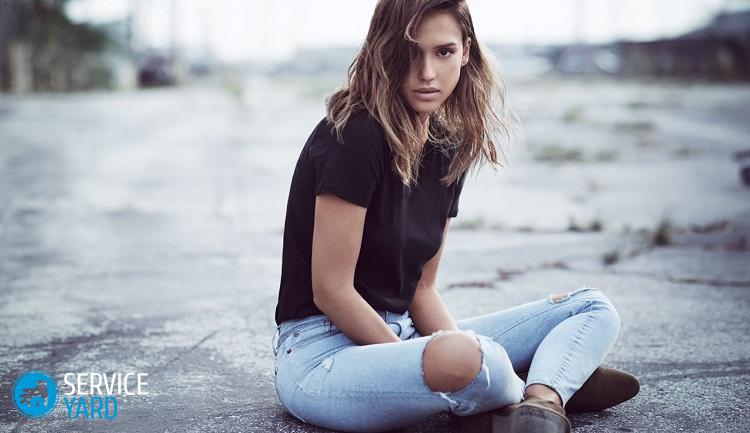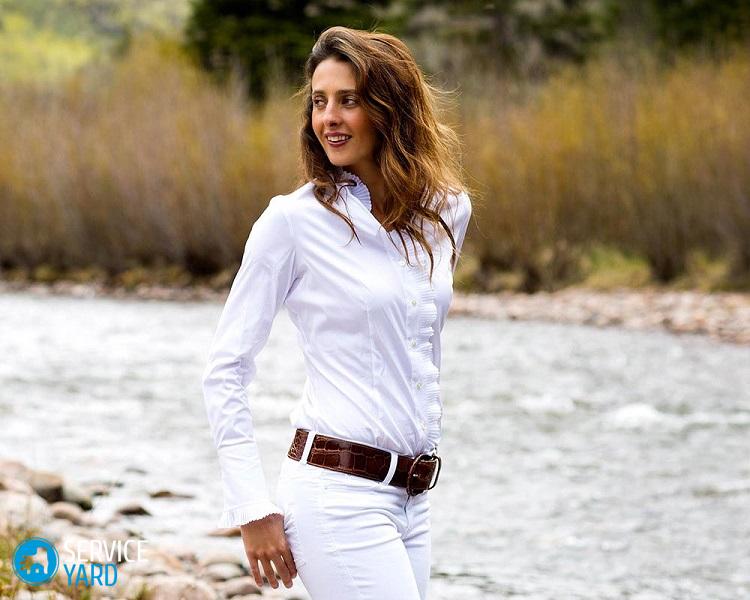How to sew clothes?

Have you lost weight without taking care of your wardrobe in advance? It's okay, this is an absolutely standard situation. It’s not necessary to run to the store in search of new clothes. You can revise your wardrobe and find something that can be reduced in size or just made smaller on the sides. Have you never done this before? Also not fatal. Any business has to start somewhere, so why not with your favorite skirt, which began to fall off the waist? How to properly take off clothes will be discussed in our article.
to contents ↑What do you need to take in?
If you wish, you can reduce the size of all things:
- a skirt;
- pants;
- a shirt;
- a blouse;
- Blazer;
- dress;
- coat;
- down jacket;
- sweater.
The most difficult thing is to adjust the jacket and coat, for this work you need some skills in working with different materials and good command of the sewing machine. Therefore, you need to start with something simpler - for example, with a skirt. But in any case, it makes sense to take care of some accessories that will certainly come in handy. You need:
- sewing machine (preferably with an overlock);
- threads matching in color;
- good tailor scissors;
- pins
- ruler;
- chalk, soap or aquamarker;
- basic patterns;
- tape measure.
Patterns
They are not always needed. For example, a skirt or shirt can be fitted without patterns, right on the figure (and even better - on a mannequin). But if it comes to a dress, coat or jacket - then, as they say, options are possible. It is possible that it will be possible to do without a pattern, but it depends on which parts of the clothes you want to sew.
The question always arises where to get the patterns. There are several answers:
- In the magazine;
- in the Internet;
- in the studio;
- in your own closet - there will probably be something there that is ideally suited in size, but already unusable;
- build on your own.
The last option is beautiful, but complicated. Great temptation to order patterns in the studio, they will come in handy again and again. But, unfortunately, not everyone has this opportunity. As for cutting for widespread things, this method is good if you need to sew something new, but not very suitable for remaking existing wardrobe items. Therefore, the easiest way to take a pattern from the magazine.
to contents ↑Customize the skirt
If you didn’t receive exactly what you need when ordering skirts through the online store, do not rush to send it back. It may well be that you will be able to remake the thing so that no one will notice. There can be only a few situations:
- the skirt fits in the waistband, but is too wide at the hips;
- the skirt is wide both in the hips and in the belt;
- in the hips, everything matches the size, the belt hangs.
Option 1
This is the easiest case. You don’t have to rip anything, just change the lines of the side seams. Just do not forget that they must be symmetrical (of course, if you do not have noticeable scoliosis, then you will have to look for other ways).
How to sew a skirt:
- We try on a skirt, turning it inside out.
- We correct it so that the middle of the front and rear parts are where they are supposed to.
- We break off the side seams as they should be located.
- Carefully remove, taking care not to drop the pins.
- We draw lines along the pins - they should be straight.
- Stitch the side seams along the markup.
- We twist, try on.
- If everything suits, we trim the allowances at a distance of 0.5-1 cm from the line.
- We iron out allowances on the sides.
- We sweat slices.
Option 2
In the second and third cases, the belt will have to be ripped off.If the skirt is wide and at the hips, with side seams we do exactly the same as in the previous method. But with the belt, everything is much more interesting:
- Measure the waist circumference.
- We add to it an allowance for a fastener.
- We shorten the belt.
- We grind fresh sections, do not forget to cut corners, iron the seam.
- We sweep the inside of the belt to the skirt and attach.
- Attach the front part to the seam.
to contents ↑Important! Only a belt is shortened in a pleated skirt or lush, everything else is regulated by landing.
Blouse and shirt
If you need to reduce the size of a blouse or shirt, a lot depends on the style - the number of decorative details, the shape of the sleeve and the neckline. But practice shows that in most cases this task can be dealt with. There are two main situations:
- the back consists of two parts;
- The back is one-piece.
Option 1
If the back consists of two parts, it is more convenient to suture along the sewing line. In this case, it is quite possible to do without a pattern, but such work is best done with an assistant:
- We try on a blouse (it is not necessary to turn out).
- We split the middle so that the blouse fits well.
- Remove and outline the seam line on the wrong side.
- Align the line with the ruler.
- Sew, trim and trim the sections.
Option 2
Theoretically, in this case, you can make a seam in the middle of the back. You can even make a crease - this is what you should do if you have to suture a man’s shirt on a yoke. But you can change the position of the side seams - it will be much easier, especially if the tucks are in place. The process is no different from suturing a skirt - in the same way you need to try on, chop and sew. But if there is a pattern, it will be even better, because you can draw all the lines on it.
If tucks are not in place
It also happens that simply failing to sew a blouse or dress. This task is somewhat more difficult than the previous one, because part of the product will still have to be cut. You certainly need:
- flog sleeves;
- open shoulder seams.
As for the side seams, then, as they say, options are possible. Maybe they won’t have to touch them at all. Most often, their position also has to be changed, but this is done the same way as with a simple change in the width of the blouse. After you have torn the sleeves and severed the shoulder seams, the process continues as follows:
- Mark the position of the shoulder seams according to the pattern or on the figure.
- If you did it according to the pattern, sweep the seams.
- Try on - if everything suits you, stitch.
- Cut allowances to normal size, i.e. no more than 1 cm.
Sleeve fit
Perhaps the most difficult stage. The presence of a basic pattern can significantly make your life easier. If there is a pattern, circle a circle around it, leave an allowance and cut the part.
Important! Do not forget about the alignment points - they should be on the armhole and on the sleeve.
Then, as when sewing any other clothes, sew an okat with a basting seam, small uniform stitches, and pull it slightly. After that, sweep the part, aligning the necessary points, try on and sew.
Another thing if you do not have a pattern. Then you have to do everything by eye. Do not rush to immediately cut the sleeve:
- Sweep it along the okata at a distance of 1-1.5 cm from the previous line, parallel to it.
- Then pull the assemblies slightly and try to sweep.
Do not be discouraged if this does not work out right away - without a pattern, the process goes much slower, and the exact position of the sleeve can only be determined empirically.
to contents ↑Pants & Jeans
Sewing trousers is a much less fun activity than resizing a skirt. There are not many situations where you can do without a global alteration. This will succeed if the fabric is thin and you need to fit them just a little bit:
- Try on the product and see how much you need to tighten it.
- Draw lines parallel to the step and side seams, at a distance of 0.5 cm from the existing ones - this is the maximum that you can afford without ripping.
- Sew the details along these lines.
- If the seams do not puff, old lines can be left.
Fundamental alteration
With jeans and trousers made of thick material, you are unlikely to be able to do without patterns and ripping, especially if you need to narrow them not one size, but 2 or 3. At the same time, an inexperienced craftswoman should not immediately take on jeans, because repeat on a typewriter branded seams are unlikely to succeed. Jeans are best left to professionals.
But you can do trousers:
- Spread all the seams, trying to do this as carefully as possible.
- Remove all threads.
- How to deal with tucks depends on the situation, sometimes they are not necessary to be torn apart at all.
- Circle the patterns - look do not mix up the details.
- Then everything is done the same way as when sewing, that is, the legs are sewn first, and only then the middle seam is sewn, while the other, with the front side on top, is embedded in one leg turned inside out.
- Sew on the belt last.
to contents ↑Important! If there is even the slightest opportunity not to touch the clasp, it is better to leave it as it is, because this is the most difficult part that is difficult to execute accurately.
Stock footage
If you need to suture your clothes more than 3 sizes, it’s not about adjustment, but about remaking. It is more convenient to cut similar parts from existing parts, that is, from shelves - shelves, and from sleeves - sleeves. If there are small parts that require special care, such as collars, flaps and pockets, they are best used completely.
- How to choose a vacuum cleaner taking into account the characteristics of the house and coatings?
- What to look for when choosing a water delivery
- How to quickly create comfort at home - tips for housewives
- How to choose the perfect TV - useful tips
- What to look for when choosing blinds
- What should be running shoes?
- What useful things can you buy in a hardware store
- Iphone 11 pro max review
- Than iPhone is better than Android smartphones




















